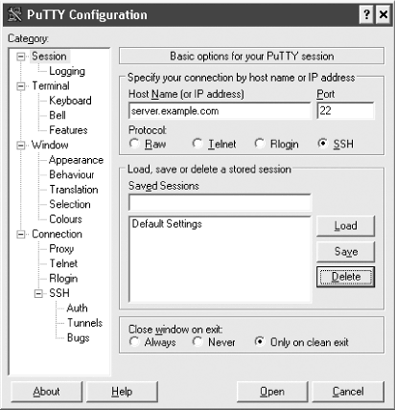 Basic Client Use
by Robert G. Byrnes, Richard E. Silverman, Daniel J. Barrett
SSH, The Secure Shell: The Definitive Guide, 2nd Edition
Basic Client Use
by Robert G. Byrnes, Richard E. Silverman, Daniel J. Barrett
SSH, The Secure Shell: The Definitive Guide, 2nd Edition
- SSH, the Secure Shell, 2nd Edition
- Preface
- 1. Introduction to SSH
- Overview of SSH Features
- History of SSH
- Related Technologies
- Summary
- 2. Basic Client Use
- Authentication by Cryptographic Key
- The SSH Agent
- Connecting Without a Password or Passphrase
- Miscellaneous Clients
- Summary
- 3. Inside SSH
- Overview of Features
- A Cryptography Primer
- Inside SSH-2
- Inside SSH-1
- Implementation Issues
- SSH and File Transfers (scp and sftp)
- Algorithms Used by SSH
- Threats SSH Can Counter
- Threats SSH Doesn’t Prevent
- Threats Caused by SSH
- Summary
- 4. Installation and Compile-Time Configuration
- 5. Serverwide Configuration
- Running the Server
- Server Configuration: An Overview
- Getting Ready: Initial Setup
- 5.3.1 File Locations
- 5.3.2 File Permissions
- 5.3.3 TCP/IP Settings
- 5.3.3.1 Port number and network interface
- 5.3.3.2 Invocation by inetd or xinetd
- 5.3.3.3 Restarting the SSH server for each connection
- 5.3.3.4 Keepalive messages
- 5.3.3.5 Idle connections
- 5.3.3.6 Failed logins
- 5.3.3.7 Limiting simultaneous connections
- 5.3.3.8 Reverse IP mappings
- 5.3.3.9 Controlling the Nagle Algorithm
- 5.3.3.10 Discovering other servers
- 5.3.4 Key Regeneration
- 5.3.5 Encryption Algorithms
- 5.3.6 Integrity-Checking (MAC) Algorithms
- 5.3.7 SSH Protocol Settings
- 5.3.8 Compression
- Authentication: Verifying Identities
- 5.4.1 Authentication Syntax
- 5.4.2 Password Authentication
- 5.4.3 Public-Key Authentication
- 5.4.4 Hostbased Authentication
- 5.4.5 Keyboard-Interactive Authentication
- 5.4.6 PGP Authentication
- 5.4.7 Kerberos Authentication
- 5.4.8 PAM Authentication
- 5.4.9 Privilege Separation
- 5.4.10 Selecting a Login Program
- Access Control: Letting People In
- User Logins and Accounts
- Forwarding
- Subsystems
- Logging and Debugging
- Compatibility Between SSH-1 and SSH-2 Servers
- Summary
- 6. Key Management and Agents
- What Is an Identity?
- Creating an Identity
- SSH Agents
- Multiple Identities
- PGP Authentication in Tectia
- Tectia External Keys
- Summary
- 7. Advanced Client Use
- How to Configure Clients
- Precedence
- Introduction to Verbose Mode
- Client Configuration in Depth
- 7.4.1 Remote Account Name
- 7.4.2 User Identity
- 7.4.3 Host Keys and Known-Hosts Databases
- 7.4.4 SSH Protocol Settings
- 7.4.5 TCP/IP Settings
- 7.4.6 Making Connections
- 7.4.6.1 Number of connection attempts
- 7.4.6.2 Password prompting in OpenSSH
- 7.4.6.3 Password prompting in Tectia
- 7.4.6.4 Batch mode: suppressing prompts
- 7.4.6.5 Pseudo-terminal allocation (TTY/PTY/PTTY)
- 7.4.6.6 Backgrounding a remote command
- 7.4.6.7 Backgrounding a remote command, take two
- 7.4.6.8 Escaping
- 7.4.7 Proxies and SOCKS
- 7.4.8 Forwarding
- 7.4.9 Encryption Algorithms
- 7.4.10 Integrity-Checking (MAC) Algorithms
- 7.4.11 Host Key Types
- 7.4.12 Session Rekeying
- 7.4.13 Authentication
- 7.4.14 Data Compression
- 7.4.15 Program Locations
- 7.4.16 Subsystems
- 7.4.17 Logging and Debugging
- 7.4.18 Random Seeds
- Secure Copy with scp
- 7.5.1 Full Syntax of scp
- 7.5.2 Handling of Wildcards
- 7.5.3 Recursive Copy of Directories
- 7.5.4 Preserving Permissions
- 7.5.5 Automatic Removal of Original File
- 7.5.6 Safety Features
- 7.5.7 Batch Mode
- 7.5.8 User Identity
- 7.5.9 SSH Protocol Settings
- 7.5.10 TCP/IP Settings
- 7.5.11 Encryption Algorithms
- 7.5.12 Controlling Bandwidth
- 7.5.13 Data Compression
- 7.5.14 File Conversion
- 7.5.15 Optimizations
- 7.5.16 Statistics Display
- 7.5.17 Locating the ssh Executable
- 7.5.18 Getting Help
- 7.5.19 For Internal Use Only
- 7.5.20 Further Configuration
- Summary
- 8. Per-Account Server Configuration
- Limits of This Technique
- Public-Key-Based Configuration
- Hostbased Access Control
- The User rc File
- Summary
- 9. Port Forwarding and X Forwarding
- Port Forwarding
- 9.2.1 Local Forwarding
- 9.2.2 Trouble with Multiple Connections
- 9.2.3 Comparing Local and Remote Port Forwarding
- 9.2.4 Forwarding Off-Host
- 9.2.5 Bypassing a Firewall
- 9.2.6 Port Forwarding Without a Remote Login
- 9.2.7 The Listening Port Number
- 9.2.8 Choosing the Target Forwarding Address
- 9.2.9 Termination
- 9.2.10 Configuring Port Forwarding in the Server
- 9.2.11 Protocol-Specific Forwarding: FTP
- Dynamic Port Forwarding
- X Forwarding
- Forwarding Security: TCP-Wrappers and libwrap
- Summary
- Port Forwarding
- 10. A Recommended Setup
- 11. Case Studies
- Unattended SSH: Batch or cron Jobs
- FTP and SSH
- 11.2.1 FTP-Specific Tools for SSH
- 11.2.2 Static Port Forwarding and FTP: A Study in Pain
- 11.2.3 The FTP Protocol
- 11.2.4 Forwarding the Control Connection
- 11.2.5 FTP, Firewalls, and Passive Mode
- 11.2.6 FTP and Network Address Translation (NAT)
- 11.2.7 All About Data Connections
- 11.2.8 Forwarding the Data Connection
- Pine, IMAP, and SSH
- Connecting Through a Gateway Host
- Scalable Authentication for SSH
- 11.5.1 Tectia with X.509 Certificates
- 11.5.1.1 What’s a PKI?
- 11.5.1.2 Using certificates with Tectia host keys
- 11.5.1.3 A simple configuration
- 11.5.1.4 Getting a certificate
- 11.5.1.5 Hostkey verification: configuring the server
- 11.5.1.6 Hostkey verification: configuring the Client
- 11.5.1.7 User authentication: configuring the client
- 11.5.1.8 User authentication: configuring the server
- 11.5.2 OpenSSH and Tectia with Kerberos
- 11.5.1 Tectia with X.509 Certificates
- Tectia Extensions to Server Configuration Files
- Tectia Plugins
- 12. Troubleshooting and FAQ
- 13. Overview of Other Implementations
- 14. OpenSSH for Windows
- 15. OpenSSH for Macintosh
- 16. Tectia for Windows
- 17. SecureCRT and SecureFX for Windows
- 18. PuTTY for Windows
- File Transfer
- Key Management
- Advanced Client Use
- Forwarding
- Summary
- A. OpenSSH 4.0 New Features
- B. Tectia Manpage for sshregex
- C. Tectia Module Names for Debugging
- D. SSH-1 Features of OpenSSH and Tectia
- E. SSH Quick Reference
- Index
- About the Authors
- Colophon
- Copyright
To get started, just run (or double-click) putty.exe. The PuTTY Configuration dialog shown in Figure 18-1 will appear:
For a quick start, locate the box labeled “Host Name (or IP address),” enter the hostname of your remote server machine, and click the Open button. A terminal window then appears and prompts you for your login name and password. Assuming
there’s nothing unusual about your SSH server, you’re done: PuTTY establishes a secure login session with the server.
Tip
PuTTY supports not only SSH, but also insecure protocols like Telnet and Rlogin. Make sure your connections are using the SSH protocol by selecting SSH on the initial PuTTY Configuration dialog. SSH is the default protocol for the other programs in the suite, such as Plink, PSFTP, and PSCP.
PuTTY comes with a second SSH terminal client, Plink, which is reminiscent of the ssh client of OpenSSH and Tectia. For a quick start, open a command window and type:
C:> plink [email protected]
This command connects you via SSH to server.example.com, logging in as remote user smith.
Plink is most appropriate for noninteractive use: for example, setting up tunnels for port forwarding, or running inside batch jobs. It can also handle interactive logins, but PuTTY is a better choice, particularly for screen-based programs like text editors. The Windows command line is not a particularly good terminal emulator.
The plink client has many command-line options, similar to those of ssh. Run plink by itself to see a list of valid options, as shown in Table 18-1.
Table 18-1. plink command-line options
Option | Meaning |
|---|---|
1 | Use SSH-1 protocol. |
2 | Use SSH-2 protocol. |
C | Use compression for the SSH connection. [7.4.14] |
-i
| Use the private key
|
-l
| Specify the remote username (if omitted, it defaults to your local username). |
-load
| Load settings from a saved
|
-m
| |
-pw | Use password
|
-P | Use TCP port
|
-s | Use an SSH subsystem. [5.8] |
-t | Allocate a pseudo-terminal (pty). |
-T | Do not allocate a pseudo-terminal. (pty). |
-v | Print verbose diagnostics. |
V | Display the program version. |
Instead of an interactive terminal session, PuTTY and Plink can run a single command of your choice, then exit immediately. It’s simplest with Plink: just append the remote command to the Plink command line. For example, to run the ls (list files) command on a remote Linux machine running an SSH server, type:
C:> plink [email protected] ls
With PuTTY, visit the PuTTY Configuration dialog and look under Connection/SSH. Fill in the blank labeled “Remote command,” then connect. The command will run and PuTTY will terminate afterward.
-
No Comment
